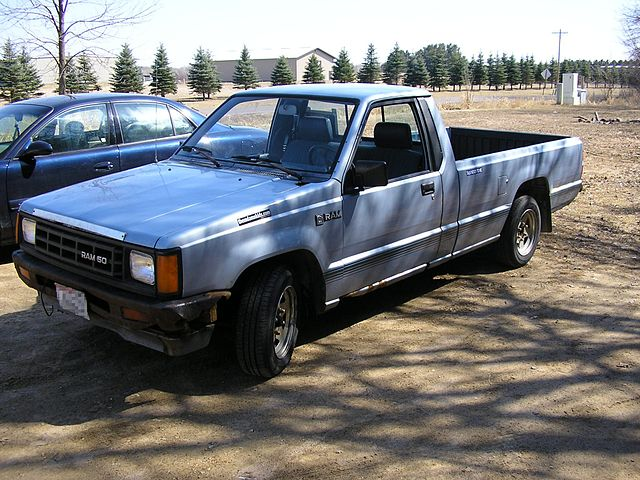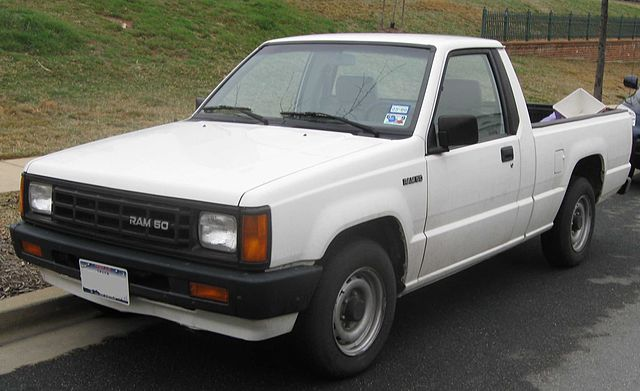The Dodge Ram 50 pickup (known as the Dodge D50 from 1979 – 1980) was manufactured by the Japanese car manufacturer Mitsubishi Motors and marketed by the Chrysler Corporation from 1979 to 1993 under its own brand, Dodge.
Plymouth also received a version, which was marketed under the Arrow Truck name from 1979 to 1982. From 1982 Mitsubishi itself began to sell the car in the USA as the Mitsubishi Mighty Max, known in Europe as the L200.
Dodge Ram 50 (D50) First Generation (1981-1986)
The first generation was launched in 1979, and it was known as the Dodge D50 until 1980. From 1981 the D50 designation was dropped, after which the pickup continued to be marketed under the name Dodge Ram 50 until the end.
Dodge D50 (1979-1980)
The Dodge D50 was a fairly compact pickup truck with dimensions (LxWxH) of 4.7 x 1.65 x 1.54 meters. It had a wheelbase of 2.77 meters, a 1.95-meter long platform, and a payload of 635 kg.
A total of two Mitsubishi engines provided propulsion: a 2-liter and a 2.6-liter four-cylinder (for sport). While the base models came with a four-speed manual transmission, the higher trim levels got a five-speed gearbox. Optionally, the Dodge D50 was also available with a three-speed automatic transmission and 14-inch wheels with radial tires.
Only one year after the market launch, the Dodge D50 was able to gain a reputation as a rather brisk and economical workhorse. But you also quickly learned to appreciate its relatively spacious driver's cab with space for two people.
Dodge Ram 50 (1981-1986)
In 1981, the pickup was renamed as the Dodge Ram 50. At the same time, a 4WD version (all-wheel-drive version) was introduced, which was called "Power Ram" and made do with the 2.6-liter engine. The Dodge Power Ram pickups were generally considered to be quite off-road capable.
The compact Dodge pickups were offered in the trim levels Custom, Royal, Sport and Big Horn. The Dodge Ram 50 featured independent front suspension, while the rear featured traditional leaf-spring rear suspension.
A small facelift was carried out for the '83 model year, where, among other things, the large headlights were replaced by smaller double headlights. From 1983 to 1985, the range of engines was expanded with a diesel version.
The 1983 turbodiesel featured a TC05 with no wastegate turbo and produced 60kW/80hp and 169Nm of torque. In 1984 and '85, turbo diesel with a turbocharger TD04 was installed, which produced an output of 64 kW/86 hp and 182 Nm of torque.
Dodge Ram 50 Second Generation (1987 to 1993)
The Dodge Ram 50 was redesigned for the '87 model year, even though its successor - the Dodge Dakota - was presented in the same year. Nevertheless, the Ram 50 remained in the program for another seven years. The reason may have been its compact size since the Dakota was already a mid-size pickup.
In the 2nd generation of the Dodge Ram 50, the diesel option was discontinued, and the 3-speed automatic on the 2.6-liter models was replaced with a 4-speed automatic. The pickup was also offered with two loading areas (platforms) of different lengths - 1.83 and 2.23 meters, both of which could be ordered with a wheelbase of 2.68 or 2.95 meters.
Tinted glass, carpet, and an adjustable steering column were now standard, and for the first time, the Ram 50 was also offered with an extended cab. While the 1988 and '89 models remained largely unchanged, the powertrains (2.0L and 2.6L I4) were replaced on the 1990 models hp A 3.0-liter V6 engine with 106 kW/142 hp was available as an option (both available with the 4-speed automatic transmission).
The Dodge Ram 50 had hardly changed in the following model years - apart from a few new colors.
Conclusion
In 1993, the Chrysler Group discontinued the Dodge Ram 50; even though it ultimately created a gap in the price and class segment, the desire for independence was probably simply greater here.
The Dodge Ram 50 and the Mighty Max from Mitsubishi were never as popular as some competitors' models - for example, from Nissan and Toyota, not to mention the Chevrolet S10 or the Ford Ranger. But the Dodge Power Ram 50 was one of the cheapest pickups in its class in some equipment lines.
As always, we recommend Coverking for all of your protection needs. They have custom protective equipment ready for any vehicle on the market anytime. Check out their catalog and see for yourself. Coverking is the official protective equipment supplier for most automotive brands. So, the manufacturers agree that they are the best.
Resources
- https://automobile.fandom.com/wiki/Dodge_Ram_50
- http://jfephraim.weebly.com/uploads/1/0/2/9/10296291/dodge_ram_d50.pdf
- https://www.dodge-wiki.com/wiki/Dodge_Ram_50
- https://tfltruck.com/2018/06/truck-rewind-mighty-dodge-ram-d50-pickup-truck/
- http://www.mightyram50.net/vbulletin/showwiki.php?title=History+and+Background:History
- https://www.allpar.com/threads/dodge-ram-50-and-plymouth-arrow-japanese-pickup.229490/
- https://en.wikipedia.org/?title=Dodge_Ram_50&redirect=no
Tankut Basar
Tankut Basar is an ARA (American Rally Assoc.) Racing Driver and an FIA Bronze Category License Holder. His passion for driving began with karting like most racers. He started racing internationally at the age of 22. Tankut loves everything car-related and will keep enjoying the drive until the end.







